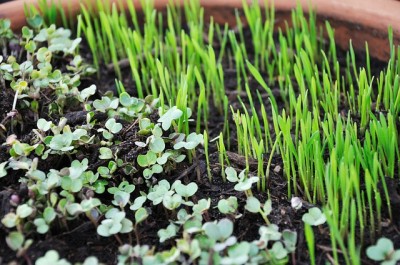Microgreens are essentially immature plants, such as greens, lettuce and herbs, that are harvested when they are about an inch in height after about 10 days to three weeks of sprouting. Just about any lettuce, green or herb can be grown as a microgreen and harvested for powerful plant nutrition.
Microgreens can be grown as single or mixed plant varieties (such as mesclun mixes), and the flavors range from mild to spicy.
Specific examples of plants that can be grown as microgreens include mustard, kale, endive, arugula, beet greens, spinach, tatsoi, radish greens and watercress.
Why Grow Microgreens?
Microgreens have a very concentrated flavor compared to the original vegetable, and can be used in a variety of dishes, such as adding them to salads, sandwiches or stir-fry. They also can be grown during winter, helping you get your “garden fix” when temperatures are frigid.
Microgreens pack a lot of nutrition inside their tiny leafy bodies.
Microgreens: Without A Doubt The Best Kept Secret In Indoor Self-Reliance Gardening…
They contain many of the health benefits that sprouts do, but unlike sprouts, which are grown only in water, microgreens are grown in soil or another growing medium where they absorb minerals, adding more nutrition. Microgreens undergo more photosynthesis than sprouts do, which increases their nutrition even more. They also have more fiber content than do sprouts.
For example, leafy greens are good sources of beta-carotene, iron and calcium, and dark leafy greens such as kale and chard are high in lutein and zeaxanthin.
Microgreens require minimal amounts of sunlight and space, and therefore can easily be grown inside homes within compact spaces, including in your kitchen or on your windowsill.
Microgreens are expensive to buy at grocery stores, making growing your own a very economical option. By doing this, you also will be able to avoid pesticides.
How to Grow Microgreens
Materials:
- A suitable growing container with drainage holes. This can be just about any type of container that you can grow plants in, including a nursery flat, takeout boxes, peat pots or traditional plant pots.
- Organic potting mix or soilless seed-starting mix (with vermiculite).
- Can be either microgreen mixes or any sort of greens, lettuce or herb that you would like to grow.
- Lightweight plastic or clear plastic domed lid.
Directions:
1. Fill your chosen container with the potting mix or seed-starting mix. Place a drip tray or a saucer underneath to catch excess water.
2. Scatter your seeds so that they are about 1/8 to ¼ inch apart and lightly cover them with approximately 1/8 inch of soil/potting mix.
3. Gently and thoroughly water the seeds. If you are using a soilless seed-starting medium, sprinkle the vermiculite on top of the soil just prior to watering.
4. Place your growing container in a spot that will receive at least four hours of sunlight every day. South-facing windows are best, but eastern or western-facing sunlight is also sufficient.
5. For optimal sprouting conditions (warm and moist), place the lightweight plastic or a clear plastic dome lid over your growing container. After the seeds sprout, remove the plastic.
Get Everything You Need To Grow Your Microgreen Garden Here…
6. Keep the soil medium consistently moist like a wrung-out sponge, but not too soggy. If the soil medium is too wet, the sprouting plants cannot properly take root.
Harvesting Microgreens and Starting the Next Crop
Microgreens can be harvested in about 1 ½ to three weeks after sprouting, depending on the size of microgreens that you would like to harvest. They are ready to be harvested once they have developed their first set of true leaves. The very first leaves that develop after germination are the seed leaves, which don’t resemble the true leaves of the plant.
To harvest the microgreens, snip them with scissors just above the soil level.
Because microgreens are essentially sprouts and are in such an early stage of development, you cannot re-grow a second crop from the stems of harvested microgreens. To grow another crop, scatter new seeds and cover with soil. You can remove the old roots if you wish, but they are a good source of organic matter if left where they are.
By planting a new crop of microgreens a few days to one week after planting the first one, you will have a continuous supply throughout the year, even during winter when your outdoor garden is still “sleeping.”
Have you grown microgreens? What advice would you add? Share it in the section below:
Discover The Secret To Saving Thousands At The Grocery Store. Read More Here.
 Off The Grid News Better Ideas For Off The Grid Living
Off The Grid News Better Ideas For Off The Grid Living






